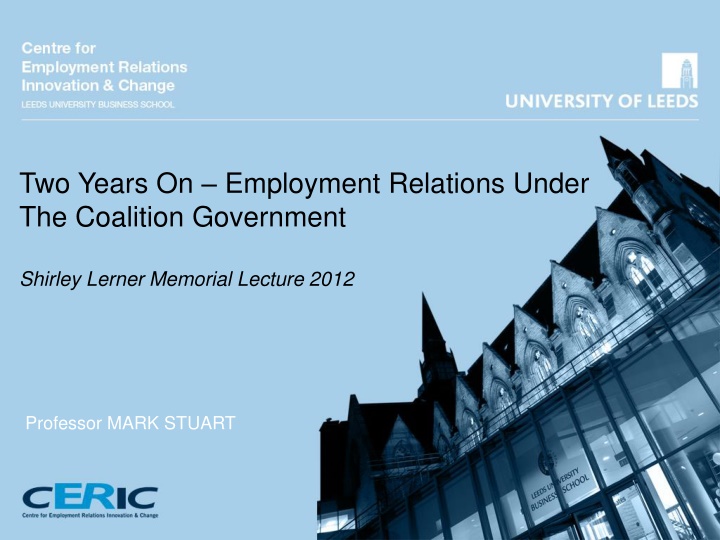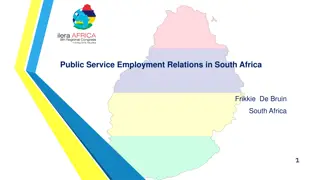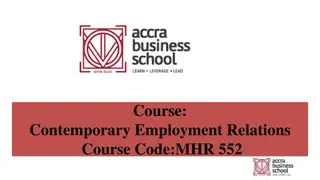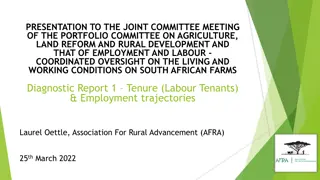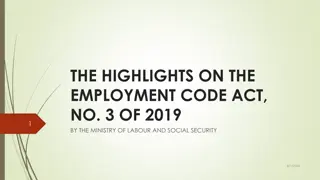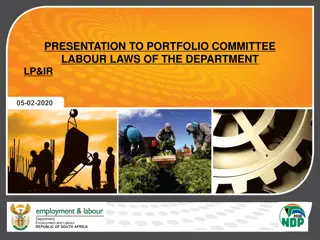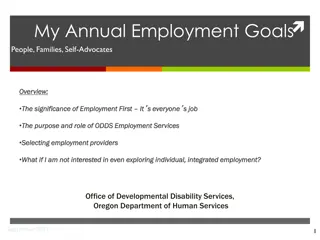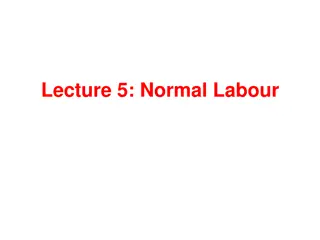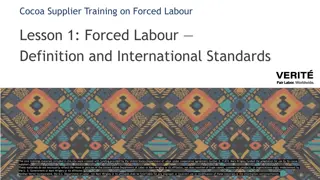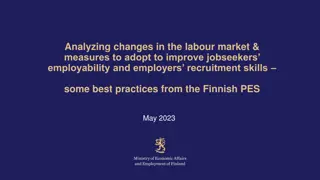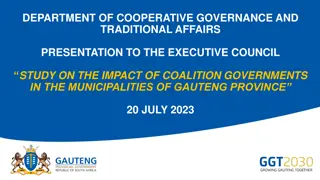Employment Relations: New Labour vs Coalition Government
Explore the contrasting approaches to employment relations under New Labour and the Coalition Government. New Labour focused on fairness, skills, and partnership, while the Coalition emphasized deficit reduction, austerity, and cuts. The shift towards private sector interests, deregulation, and marketization under the Coalition is evident, with minimal change to trade union legislation. The comparison highlights the evolving landscape of employment relations over the years.
Download Presentation

Please find below an Image/Link to download the presentation.
The content on the website is provided AS IS for your information and personal use only. It may not be sold, licensed, or shared on other websites without obtaining consent from the author.If you encounter any issues during the download, it is possible that the publisher has removed the file from their server.
You are allowed to download the files provided on this website for personal or commercial use, subject to the condition that they are used lawfully. All files are the property of their respective owners.
The content on the website is provided AS IS for your information and personal use only. It may not be sold, licensed, or shared on other websites without obtaining consent from the author.
E N D
Presentation Transcript
Two Years On Employment Relations Under The Coalition Government Shirley Lerner Memorial Lecture 2012 Professor MARK STUART
Caveats and questions Is it possible to discern a clear approach to employment relations by the Coalition? Temporal limitations Need to ask if there is a fundamental difference from New Labour Likewise, is there a discernible mood change in ER? (new responses) First two years best understood in terms of what may potentially come, wider politics of welfare reform, changing rhetoric and possibly levels of resistance
New Labour: a reminder Fairness, skills and partnership central to modernisation of employment relations Partnership Fund, ULF, UMF etc (soft regulation) Emphasis on enhancement of individual employment rights, implementation of EU directives Statutory recognition procedure and NMW Benign context , but no reversal of trade union legislation Public sector employment growth Boasted of having (one of) the least regulated labour market Neo-liberal approach, marketisation, flexible labour markets, workfare etc
Whatever the failings of the New labour agenda, there is nevertheless evidence of consistent and repeated attempts to square the circle of neo-liberalism with a human face . (Grimshaw and Rubery, 2012)
Headline approach of Coalition Guiding narrative of deficit reduction, austerity and cuts Emphasis on private sector and employer interests (against public sector) marketisation, deregulation Regulation restricts business interests one regulation in, one regulation out ; Red Tape Challenge but for employment, all regulation is up for grabs. Rebalancing of economy (public sector seen parasitic) Little interest in collective employment relations no change to union legislation (so far), kept NMW, Recognition, ULF No economic growth, back in recession, welfare reforms to stimulate jobs amid increasing worklessness and inequality
Total private and public sector employment (LFS, ONS) Year Total (000) Private (000) Public (000) Dec 2007 29, 432 23, 647 5, 785 Dec 2008 29, 349 23, 064 6, 285 Dec 2009 28, 842 22, 490 6, 352 Dec 2010 29, 159 22, 947 6, 212 Dec 2011 29, 115 23, 173 5, 942
Total Full-time and Part-time employment (LFS, ONS) Year Full- time (000) Men Women Part-time (000) Men Women Feb 2008 21, 978 14, 135 7, 844 7, 505 1, 796 5, 709 Feb 2009 21, 700 13, 879 7, 821 7, 531 1, 847 5, 683 Feb 2010 21, 137 13, 462 7, 674 7, 683 1, 893 5, 790 Feb 2011 21, 301 13, 653 7, 649 7, 928 2, 011 5, 917 Feb 2012 21, 234 13, 565 7, 668 7, 939 2, 074 5, 865
Unemployment in UK (LFS; 000s) All Rate % Up to 6 Mnths 6-12 >12 >24 Gov training/ employment prog 120 Feb 2010 2, 491 8 1, 206 556 729 272 Feb 2011 2, 478 7.8 1, 191 443 844 369 126 Mar-May 2, 452 7.7 1, 207 438 807 384 103 Jun-Aug 2, 566 8.1 1, 232 467 867 423 85 Sep-Nov 2, 685 8.4 1, 313 515 857 424 96 Feb 2012 2, 650 8.3 1, 261 506 883 423 90
Unemployment by Men and Women (LFS, 000) Year Total >12 m >24 m Men Women Men Women Men Women Feb 2010 1, 520 971 498 232 192 79 Feb 2011 1, 442 1, 036 565 280 261 108 Mar-May 1, 427 1, 026 540 268 279 104 Jun-Aug 1, 487 1, 069 564 303 302 121 Sep-Nov 1, 557 1, 128 556 301 296 128 Feb 2012 1, 514 (8.8%) 1, 136 (7.7%) 555 328 289 137
Labour market activation and welfare reform Scrapped Flexible New Deal, Train to Gain, Future Jobs Funds (FJF) and Young Person s Guarantee FJF was 1B investment over 2 years aimed at creating 150k jobs, provided by local authorities and public sector Replaced by Youth Contract; also increased emphasis on apprenticeships (extra 75k by 2013/14) Main source of activation is Work Programme 40 prime contractors (35 private sector) and large supply chain (1, 099 contractors) 7 contracts held by Ingeus Deloitte, 5 by A4E
Labour market activation and welfare reform Work Programme payment by results scheme 565k referrals by Feb 11, 519k attachments this does not mean sustainable jobs no data on job outcomes Other initiatives feed into or support WP Pre-work programme, Mandatory Work Activity, work placements Reforming wider benefits, such as Incapacity/ Employment and Support Allowance (ESA) From April (12) 12 month limit on non-means tested ESA Will push people onto JSA or out of benefits altogether
Incapacity Benefit Reform Beatty and Fothergill (2011) estimate (11-14) IB reform will: Reduce IB claimants by 970, 000 (out of 2.6m) Remove 580, 000 from benefits entirely Increase JSA by 280, 000 Increase compulsory labour market engagement by 910,000 Historically, IB has been used politically to hide true scale of unemployment...no longer (could increase by 600k) However....
Incapacity Benefit Reform The reforms will hit the weakest local economies in Britain hardest. It is the older industrial areas of the North, Scotland and Wales...that face the biggest upheaval The Coalition Government is presiding over a national welfare reform that will impact principally on individuals and communities outside its own political heartlands (Beatty and Fothergill, 2011: 19 emphasis added)
Equality Welfare reform has clear geographical implications But, the Coalition intends to address the causes of inequality and shine the light of transparency in organisations Scrapped socio-economic duty (requiring public bodies to consider social disadvantage when designing their services) Put on hold gender pay audits for organisations with more than 250 employees (will not commence, amend or repeal S78 of Equality Act); voluntary action instead
Equality Fawcett Society and Women s Budget Group point out disproportionate impact on women Legal challenge to 2010 emergency budget (Conley, 2012) More widely, in terms of: Public sector restructuring job loss, pay freezes, regional pay Reform of welfare system more than 70% of 18bn social security and welfare cuts will fall on women in-work benefits, lone parents, reduced child care support etc Rise in women s unemployment turning back time on equality women s unemployment the highest for 25 years
Employment policy and law Employment Law Review (2010-2015). Aims to: Improve growth through increased labour market flexibility; Reduce burden on business; Give employers the confidence to take people on All employment laws are in scope The Red Tape Challenge also took 2000 views relating to 160 employment-related regulations (October 2011)
Employment Policy and Law Recognising that Britain has one of the most lightly regulated labour markers among developed countries: In setting out plans to radically reform employment relations, we want to safeguard workers rights, while deregulating the onerous and unnecessary demands on business ....BUT What we need to do is balance our support for job creators to grow their businesses with the need to provide job security in these uncertain times (Vince Cable, Nov 2011)
Employment Policy and Law That s why we are doubling the qualifying period for the right to claim unfair dismissal from 1 to 2 years ! Not extending right to request time to train for SME s Removed Default Retirement Age Taking soundings and consultations on variety of issues Asked Adrian Beecroft (multimillionaire venture capitalist, and large Tory donor) to examine how employment law could be overhauled to boost economic growth
Employment Policy and Law Reducing workplace disputes consultation Fee based system for Tribunals though fees won t be a barrier to justice streamlined system Protected conversations (poor performance reviews) Compensated no-fault dismissal for micro firms (general review on dismissals) Simplify TUPE rules (unnecessarily gold plated EU laws); scrapped two-tier code Consultation on collective redundancies (from 90 days)
Enterprise and regulatory reform
Employment Policy and Law Review on Sickness Absence Red Tape Challenge covers: Compliance and enforcement (868); letting people go (699); managing staff (422); taking people on (62) Most responses focus on NMW, maternity pay and unfair dismissal, with initial anti regulatory statements from IoD and other business groups Response mainly to simplify and dampen regs (AWD) Of 159 regulations examined, 40% to be merged, simplified or scrapped Employers Charter need to address power imbalance
Lobby interests with most ministerial meetings Dept CBI TUC Total 168 92 BIS 48 30 DWP 27 18 Cabinet Office 13 14 Treasury 23 0 Prime Minister 8 0
Trade union membership in the UK (Employees, 000) (Brownlie, 2012) Year All Density Private Public Members 2, 914 Density 16.1 Members 4, 092 Density 59 2007 7, 006 28 2008 2009 2010 2011 6, 876 6, 715 6, 532 6, 389 27.4 27.4 26.6 26 2, 786 2, 611 2, 464 2, 507 15.5 15.1 14.2 14.1 4, 089 4, 105 4, 068 3, 882 57.1 56.6 56.3 56.5 Change 10- 11 07-11 -143 -0.6 43 -0.1 -186 0.2 -617 -2.0 -407 -2.0 -210 -2.5
Employees pay affected by collective agreement (Brownlie, 2012) Year All (%) Private (%) Public (%) 2007 34.6 20.0 72.0 2008 33.6 18.7 70.5 2009 32.7 17.8 68.1 2010 30.8 16.9 64.5 2011 31.2 16.9 67.8
Trade Union Reform Campaign No new Coalition legislation on unions, as yet But ongoing debate around union facility time Encouraged by (the Stormtroopers of) The Taxpayers Alliance annual report on facility time Private members Bill on Trade Union officials (Refund of Pay to Employers) TURC launched early 2012: no to taxpayer funded union activity; commercial rents; public bodies should not collect union dues; scrap modernisation and learning funds; transparency on public funding officials called Pilgrims
The hard left leadership of the TUC and some of their affiliated unions should wake up and realize that their union members are taxpayers too. They don t want their tax money wasted on shop stewards who are paid by the taxpayer and then use that position to leapfrog up the union movement The Labour Party has positioned itself as the supporters of the Union Barons. That leaves space for the Conservative Party to position itself as the supporter of the ordinary union member. Comment on Robert Halfon (2012) Stop the Union-Bashing. Demos
Industrial Action Talk of new class war by some union leaders Coalition denounce strikes, gesture towards possible need for reform supported by CBI call play off public/private Demonstrations and strikes increasing Major strikes focus on pensions Largest on 30th November 2011 involved more than 20 unions and upwards of 1 million members Damp Squib according to Cameron M10 involves up to 400k members and more strikes on way Largest set piece strikes for generation
Labour Disputes (ONS) Year Working days lost (000) 1, 403 Stoppages Workers involved (000) 1, 538 Feb 2012 135 Feb 2011 Feb 2010 2007 2002 1996 1989 1984 1982 370 440 1, 041 1, 323 1, 303 4, 128 27, 135 5, 313 99 100 142 146 244 701 1, 221 1, 538 134 203 745 943 364 727 1, 464 2, 103
Wider responses and resistance Mobilisation (Kelly, 1998) Counter movement For if market economy was a threat to the human and natural components of the social fabric, as we insisted, what else would one expect than an urge on the part of a great variety of people to press for some sort of protection (Polanyi, 1944: 156) Relief and the urban crisis A placid poor get nothing, but a turbulent poor sometimes get something (Fox Piven and Cloward, 1971 :338) Wider resistance (Shareholder Spring), but likely impact?
Conclusions Coalition s liberal-market approach represents continuity with New Labour delivered with Panglossian optimism! But are cutting back heavily on welfare supports, minimum standards and looking to deregulate employment further coalition is taking the flexible labour market to another level. It is not only watering down minimum standards but also setting these low-quality jobs as the standard against which other jobs should be judged, leading to a downgrading of employment conditions to that found at the bottom of the flexible labour market. (Grimshaw and Rubery, 2012: 122) Targets public sector, (cynically) hits already geographically deprived areas, non-Tory heartlands, and women Resistance increasing, reversals may happen, depending on growth, but prospects for employment relations look bleak
